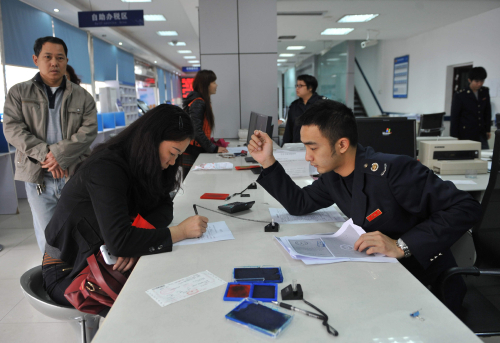 |
|
BETTER, FASTER, STRONGER: A small business owner fills out registration forms at the local taxation authority in Yulin, Guangxi Zhuang Autonomous Region, on April 24 (ZHANG AILIN) |
In November 2013, the Third Plenary Session of the 18th Central Committee of the Communist Party of China (CPC), held in Beijing, produced an ambitious reform plan, explicitly listing 60 tasks in 15 key areas.
Over the past 12 months, great achievements have been made in that regard, with a wide range of reform measures being implemented nationwide. Experts, however, warn that only the easy part has passed and an arduous road still lies ahead.
This round of comprehensive reform reaches beyond economic changes and will cover the market economy, rule of law, cultural development, social harmony and ecological progress.
The detailed plan includes giving a greater role to market forces, transforming government functions, granting greater autonomy to state-owned enterprises, further opening up of the market and allowing farmers to enjoy more property rights over collectively-owned rural land. The plan also aims to lift restrictions on sales of rural construction land and establish a universal social safety net.
Lian Weiliang, Vice Minister of the National Development and Reform Commission, said that reforms on a wide range of areas, including economy, politics, culture, society, ecology and Party building, have been bolstered over the past year.
"In China, the blueprint for comprehensively bolstering reforms has been drawn. It's all about how to implement those reform measures. Third-party organizations should be employed for evaluation and supervision," Lian suggested.
"Some of the planned reforms are being carried out, while some are still in the pipeline," Ding Yuanzhu, a researcher with the Chinese Academy of Governance in Beijing, commented. "That's because of the nature of reforms in different areas. Some areas are tougher to reform, and the government is still studying how to do it."
A change of roles
Experts say that the most impressive reform over the past year is the reform on the government itself. The Chinese Government has greatly cut red tape and refrained from too much intervention with the market, aiming to give the market a decisive role in allocating resources, as promised in last year's Third Plenary Session of the 18th CPC Central Committee.
Handling the relationship between the government and the market in a market economy is a core issue in China's comprehensive reform. The decision of the Third Plenary Session of the 18th CPC Central Committee to let the market play a much greater role is a historic breakthrough. For a long time, China has adopted a policy-led market system. The top leadership has decided that now is the time to profoundly change the old pattern.
The current Chinese Government, which took office in March 2013, has attached great importance to the transformation of its functions, focusing on shifting from an authoritative presence to a more supervisory presence.
To date, 632 administrative approval procedures have been canceled or delegated to lower-level governments. The State Council, China's cabinet, plans to cancel or decentralize an additional more than 200 administrative approval procedures before the end of this year to unleash more market dynamics.
Businesses benefit the most from the move. According to a survey conducted by the National Bureau of Statistics, 43.1 percent of the 4,400 surveyed businesses said that they had been positively affected by the move, and 81.6 percent were satisfied with it.
Bo Guili, a professor at the Chinese Academy of Governance, said that cutting red tape is of vital importance to give full play to the market's decisive role in allocating resources.
"If businesses are not given the decision-making autonomy, the role of the market can never be exerted. For instance, if a company can't decide what to produce and has to report to regulatory authorities every time it tries to open a new production line, then resources can't be efficiently allocated," Bo said.
According to Bo, in order to let the market play a vital role and unleash market vitality to the largest extent, the government should allow the market, social groups and local governments to handle whatever should be within their respective responsibilities.
The professor, however, said that cutting red tape is not the end of the story. "The government should intensify present- and post-establishment supervision accordingly," he said.
Fan Jianping, chief economist with the State Information Center, agreed with Bo, saying that cutting red tape is the biggest achievement among the past year's reform measures.
